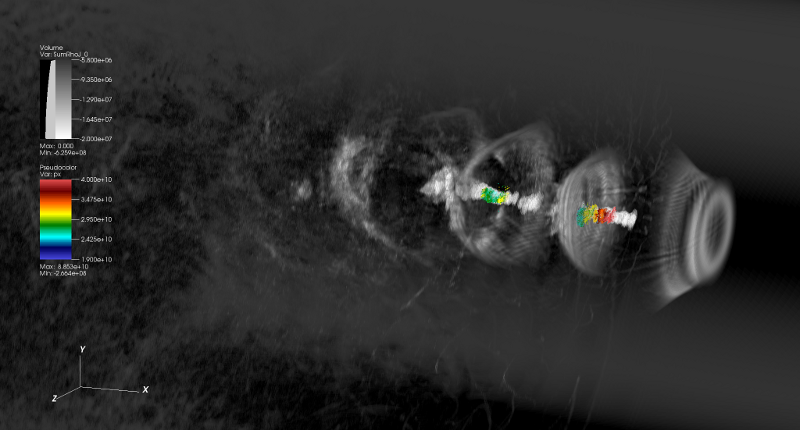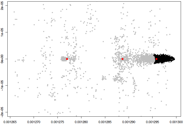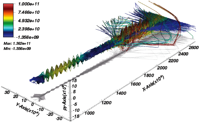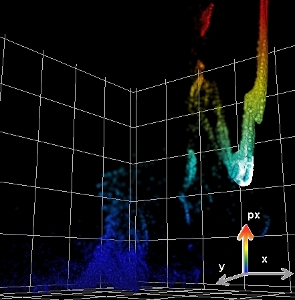This is an archival copy of the Visualization Group's web page 1998 to 2017. For current information, please vist our group's new web page.
Analysis of Laser Wakefield Accelerator Simulation Data
- Overview
- High-performance Visual Data Exploration
- Automatic Beam Detection
- Automatic Beam Path Analysis
- References
Overview
|
||||||||||||||||||||||
| Overview of the framework for laser wakefield accelerator particle simulation data. | ||||||||||||||||||||||
Analysis and knowledge discovery from large, complex, multi-variate laser wakefield particle accelerator (LWFA) simulation data is a challenging task. One main feature researchers are interested in are beams of high-energy particles formed during the coarse of LWFA simulations. To enable efficient and accurate analysis of these particle beams, dedicated mechanisms for selection and detection of particle beams are needed. Furthermore, to support analysis of selected particle bunches of interest effective visualization methods are required.
We address these challenges via a combination of state-of-the-art data management, high-performance visual data exploration, and automatic data analysis. Efficient data management serves as the basis to enable fast data analysis. We adapted HDF5 FastQuery as data interface. HDF5-FastQuery is based on H5Part and the data management system FastBit.
To enable visual analysis of particle beams in extremely large and complex scientific data we integrated HDF5 FastQuery and the advanced visualization system VisIt. This unique combination supports high performance visual exploration of extremely large data. This approach, while applied here to accelerator science, is generally applicable to a broad set of science applications, and is implemented in a production-quality visual data analysis infrastructure.
While visual exploration of LWFA simulation datasets is effective, manual exploration of a large number of datasets is time consuming. To enable more efficient and accurate analysis of particle beams and to support analysis of a larger number of datasets, we developed two novel methods for automatic beam analysis. The automatic beam detection algorithm is aimed at identification of the highest-energy particle bunch in a simulation. The algorithm is based on a combination of bunch lifetime estimation and data clustering and is implemented in R using HDF5 FastQuery for data access. The automatic beam path analysis on the other hand has the goal to enable efficient temporal classification of multiple particle bunches based on the complete temporal history of the particles that form them. Automatic analysis of particle beams based on temporal particle paths enables accurate classification of particle beams and supports analysis of the temporal beam evolution. The algorithm is implemented as a stand-alone C++ application using HDF5 FastQuery. We use VisIt for visualization of the results of the automatic beam path analysis.
High-performance Visual Data Exploration
Our approach for high-performance visual data exploration combines and extends techniques from high performance scientific data management and visualization, enabling researchers to gain insight from extremely large, complex, time-varying laser wakefield accelerator simulation data. Histogram-based parallel coordinates are used as a visual information display as well as an interface for guiding and performing data mining operations. Multi-dimensional thresholding is used as vehicle for selecting particles of interest at a particular timepoint. We use FastBit, a state-of-the-art index/query system for data extraction and subsetting. All parts of our approach are integrated into the visualization system VisIt providing a product-quality visual data analysis infrastructure. Using our system, scientists are now able to track interesting particles in a fraction of a second, a task which used to take them hours using a naive approach. For more details see here.
Automatic Beam Detection
The automatic beam detection is aimed at identification of particle beams in LWFA simulations. The method first identifies locations with high density of particles in the space-time domain, based on maximum extremum point detection on the particle distribution. We analyze high density electron regions using a lifetime diagram by organizing and pruning the maximum extrema as nodes in a minimum spanning tree. Independent of the lifetime diagram analysis, we partition the multivariate data using fuzzy clustering to detect time steps that may contain a high quality electron beam. To estimate spatially confined beams we then combine the results from the fuzzy clustering and the bunch lifetime analysis. For more details see here.
Automatic Beam Path Analysis
Numerical simulations of laser wakefield particle accelerators play
a key role in the understanding of the complex acceleration process and
in the design of expensive experimental facilities. As the size and
complexity of simulation output grows, one main challenge is the need
for computational techniques that aid in scientific knowledge
discovery. The automatic beam path analysis consists of a set of
data-understanding algorithms that work in concert in a pipeline
fashion to automatically locate and analyze high energy particle
bunches undergoing acceleration in very large simulation datasets.
These techniques work cooperatively by first identifying features of
interest in individual timesteps, then integrating features across
timesteps, and based on the information derived perform analysis of
temporally dynamic features. This combination of techniques supports
accurate detection of particle beams enabling a deeper level of
scientific understanding of physical phenomena than has been possible
before. By combining efficient data analysis algorithms and
state-of-the-art data
management we enable high-performance analysis of extremely large
particle datasets in 3D. The automatic analysis of particle beams based
on temporal particle paths enables accurate classification of particle
beams and supports analysis of the temporal beam evolution. The
automatic beam path analysis is implemented as a stand-alone C++
application using HDF5 FastQuery. The visualization system VisIt is
used for visualization of analysis results. For more details see here.
 |
||
| Example illustrating the application of the automatic beam path analysis to a large 3D particle dataset. The particles of the two detected particle bunches are shown in color with color indicating momentum in x direction (px). A volume rendering of the plasma density (gray) illustrates the plasma wave. |
References:
[1] O. Rübel, C.G.R. Geddes, E. Cormier-Michel, K. Wu, Prabhat, G.H. Weber, D. M. Ushizima, P. Messmer, H. Hagen, B. Hamann, and E.W. Bethel, "Automatic Beam Path Analysis of Laser Wakefield Particle Acceleration Data", IOP Computational Science & Discovery, 2009 (to appear)
[2]
O. Rübel, Prabhat, K. Wu, H. Childs, J. Meredith, C.G.R. Geddes, E.
Cormier-Michel, S. Ahern, G.H. Weber, P. Messmer, H. Hagen, B. Hamann
and E.W. Bethel, "High Performance Multivariate Visual Data Exploration
for Extremely Large Data." SC08, Austin TX, November, 2008. LBNL-716E.
(PDF)
(BibTeX)
[3] Daniela Ushizima, Oliver Rübel, Prabhat, Gunther Weber, E. Wes Bethel, Cecilia Aragon, Cameron Geddes, Estelle Cormier-Michel, Bernd Hamann, Peter Messmer, Hans Hagen. "Automated Analysis for Detecting Beams in Laser Wakefield Simulations". 2008 Seventh International Conference on Machine Learning and Applications, Proceedings of IEEE ICMLA'08, 2008. LBNL-960E. (PDF) (Bibtex)
[4] C. G. R. Geddes, E Cormier-Michel, E. H. Esarey, C. B. Schroeder, J.-L. Vay, W. P. Leemans, D. L.. Bruhwiler, J. R. Cary, B. Cowan, M. Durant, P. Hamill, P. Messmer, P. Mullowney, C. Nieter, K. Paul, S. Shasharina, S. Veitzer, G. Weber, O. Rübel, D. Ushizima, Prabhat, E. W.Bethel, K. Wu. "Large Fields for Smaller Facility Sources." SciDAC Review, Number 13, Summer 2009. LBNL-2299E. (PDF at the SciDAC Review website), (bibtex)
[5] K. Wu, S. Ahern, E. W. Bethel, J. Chen, H. Childs, E. Cormier-Michel, C. Geddes, J. Gu, H. Hagen, B. Hamann, W. Koegler, J. Lauret, J. Meredith, P. Messmer, E. Otoo, V. Perevoztchikov, A. Poskanzer, Prabhat, O. Rübel, A. Shoshani, A. Sim, K. Stockinger, G. Weber, W.-M. Zhang. "FastBit: Interactively Searching Massive Data." In Journal of Physics Conference Series, Proceedings of SciDAC 2009. (LBNL-2164E) (PDF), (bibtex)




